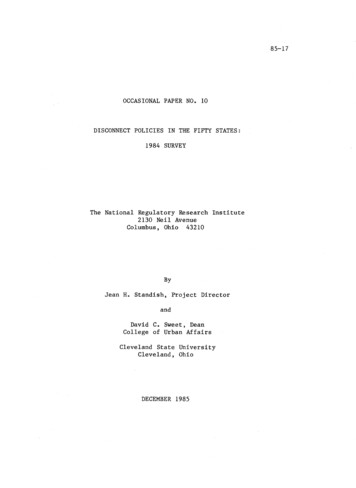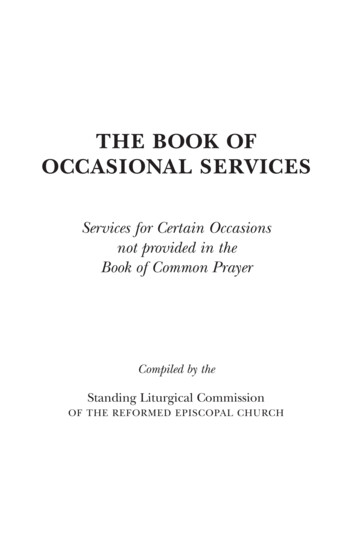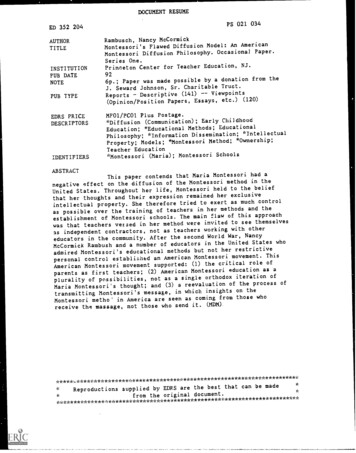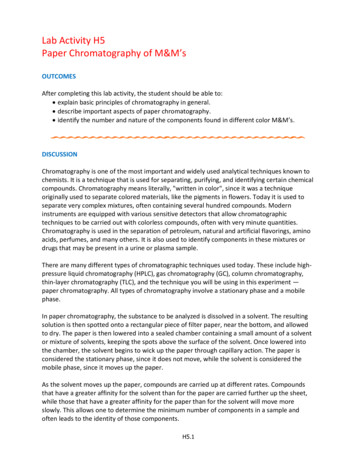
Transcription
85-17OCCASIONAL PAPER NO. 10DISCONNECT POLICIES IN THE FIFTY STATES:1984 SURVEYThe National Regulatory Research Institute2130 Neil AvenueColumbus, Ohio 43210ByJean H. Standish, Project DirectorandDavid C. Sweet, DeanCollege of Urban AffairsCleveland State UniversityCleveland, OhioDECEMBER 1985
FOREWORDFrom time to time NRRI publishes in its Occasional Paper seriesstudies or reports done by others that deserve widespread disseminationamong our clientele. Such a report is the present one on disconnectpolicies of energy utilities in the fifty states and the District ofColumbia. It was initially contracted for by the State of Ohio PublicUtilities Commission and done at the Energy Program of the College ofUrban Affairs, Cleveland State University.We appreciate the willingness of Chairman Thomas Chema of the PUCOto making this national research product available to the rest of theregulatory community. The views and opinions of the authors do notnecessarily state or reflect the views, opinions, or policies of theNRRI, the NARUC, or NARUC member commissions.Douglas N. JonesDirector, NRRIColumbus, OhioDecember 1985i
ACKNOWLEDGEMENTSSpecial thanks are given to Kathryn Wertheim Hexter of the East Ohio GasCompany for her advice, to Carol Werner of the National Consumer Law Centerfor the excellent background information provided, and to Mary Ann Orlinskiof the Public Utilities Commission of Ohio for her straight-forward advice.Both Diane Edge and Laurie Caylen of The Urban Center staff deserve specialnotice for their efficient and professional assistance in assembling thefinal product.ii
TABLE OF CONTENTSMethodo logy.Overvi ew . . .2Winter Restrictions . .4Payment P1 ans. . . . . .9Reconnect Regulations . . 12Notification and Linkages to EnergyAssistance Programs. .· 15Renter Protections . . . . . . . . .· 17Tracking Disconnections and ArrearagesPolicy Descriptions . .19· 21AlabamaAlaska. .ArizonaArkansas. .California . .Co lorado. . .ConnecticutDe 1aw.are. .Di stri ct of Co 1umbi a. .FloridaGeorgiaHawaii . . .Idaho . .Illinois . .IndianaIowa . . . .Kansas. .Kentucky. .LouisianaMai ne . . . 22 23 24 25· . 27· 29 . . 32 35· 37. . . 39 41 43· . 44 47 51· . . . 53. . . . . . 55 . 57 . 60 . 61iii
TABLE OF CONTENTS(continued)PageMaryl and. . · . 63Massachusetts· . 67Michigan . .· 71Mi nnesota . .Mississippi· 7679Mi ssouri. . 80Montana . .· . 84Nebraska. .· 87Nevada. . . . 8889New Hampshi re .New Jersey. 93New Mexi co. .· . 95New York. . .· . 96North Carolina · . 99North Dakota. . 101Ohi o. . . . . 104Oklahoma . · 108Oregon. . . · . 112Pennsyl vani a. . .· . 115Rhode Is 1and. · 120South Caro 1ina.· . 123South Dakota. . 124Tennessee . . . . 125Texas - Electric Utility.Regulations.Texas - Gas Utility Regulations· 126· . . 128Utah. .· 130Vermont 133Virginia . .· 135Washi ngton .· . 136West Virginia . .· 138WisconsinWyomi ng· . 140 . . .· 144iv
TABLE OF CONTENTS (continued)PageSelected References . .· . 146Appendices . . . . . .· .147Appendix A - Questionnaire Format forDisconnect Policies Report . . . .Appendix B - Service Disconnection andReconnection Policies - 1982 . . . . .Appendix C - Summary of Policies forService Disconnection: 1982-1983Wi nter Season . . . . . . . . . . . . . . . . . . . . . . .Appendix D - Electric and Natural GasUncollectible Accounts and ServiceDisconnection. .·Publications List . . .148.150.157.160.168v
METHODOLOGYInformation about utility residential disconnect regulations wassolicited by both telephone and letter. The state regulatory commissionswere called and information was gathered over the telephone. The regulations were extensive, however, and most commission staff persons offeredto mail copies of the regulations and other information to the projectteam. In most cases the disconnect policy summaries were sent back toeach respective state contact for comments and approval.Attached in the appendix is the format used for summarizing theinformation. The scope of the study prohibited including all aspectsof regulations. For example, each commission has lengthy and specificrules governing customer disputes and customer rights. This is worthyof a separate study.The purpose of the report is twofold. It describes the various wayslow income, elderly, and handicapped customers can avoid disconnectionof service in each of the fifty states and the District of Columbia.When disconnection does occur, the report describes the kinds of assistance(or barriers) which exist to help persons have their service restored,especially during the cold weather months. Although certain states standout for their unique or comprehensive approaches, many of the regulationsoffer features worth noting.This study is divided into three parts:OverviewPolicy DescriptionsAppendixFor the convenience of those interested in additional information,each regulatory commission is listed. The appendix includes referenceto some recent reports and articles.1
OVERVIEWThe regulatory commissions are usually mandated by state law to provide non-discriminatory and cost-based utility rates. In some cases thatrequirement has been expanded by recent legislative action to encompasshumanitarian procedures in dealing with low-income energy users. This,plus the realization that commission rules tend to set up a "court of lastresort for the provision or withdrawal of energy for the poor, has throwncommissions and their regulated utilities into a role somewhat akin tosocial service providers.llThe bottom line in the system of assistance and postponement of payment by the poor for utility service is -- short of allowing real sufferingto occur -- who pays the utility bills for residential customers unableto pay? Utilities are pleading to the Commiss"ions that uncollectibles aregrowing rapidly. They claim the winter moratoriums solve no problems, butrather postpone temporarily the inevitable bad debt of those who areeventually disconnected for non-payment.Many commissioners have only recently required utilities to reportstatistics related to disconnections and unpaid arrearages of residentialcustomers. When asked whether bad debt is increasing because of low incomecustomers who are unable to pay, the most often heard comment was: IIWedonlt know, but the utilities have yet to substantiate their claims. Thiswill be decided during future rate cases.1IThere does not appear to be one IIbestll model in the .fifty states fordealing with problems associated with the poor in paying their energybills. Ideally an adequate IIsafety net would exist to reliably coverutility payments for those truly unable to pay. Ideally, the poor wouldreside in energy efficient homes. Ideally, a state's tax-supported socialservices system would take care of poor people. In fact, given the bestof intentions, this has not occurred. A piecemeal set of solutions to amajor long term problem has been the norm. Regulatory commissions andutilities are regularly changing procedures for dealing with those unableto pay their bills. In fact, during this study's timeframe, at least ninestates changed policies. Many foresee future problems in finding adequateenergy assistance funds to cover low income needs. Indiana, for example,expended all of its emergency energy assistance funds by the end of lastwinter and had to scramble to find monies to reconnect the inevitable groupof seasona 111 customers whose servi ce was termi nated in the spri ng.llIINo persons interviewed in the study said there were actual fatalitiesdue to energy disconnections during cold weather months. But many areresisting the push towards indefinite postponement of payment by the poor.This is done by setting up payment plans that bring bills current priorto the next heating season. On paper this seems equitable and fair but,given another colder-than-average winter, they admit the system will likelynot work.2
This overview includes examples of some of the more interesting commission regulations covered by the study. Each state has its own approachto Itfair and equitablelG disconnect policies. In some states, such asMichigan, Illinois, Ohio, Oklahoma, Minnesota, Pennsylvania and New York,a very liberal attitude is reflected by the commissions in assuring thatcustomers will not as a minimum be without a primary energy source duringcold weather months. At the other extreme, a state like Florida with its armer climate and high elderly population, offers little protection.Instead its strategy is to direct efforts towards making residences moreenergy-efficient and, therefore, more affordable. Most states fall somewhere in between, but as evidenced in the large number of summary examples,commissions are increasingly attempting to create a safety net throughtheir regulatory powers. After all, when a person freezes to death, thereis a great community outcry Utilities, which are often portrayed in anegative image, are aware of damage to their own corporate image andso they, too, are trying to find ways to avoid cold weather disconnections. Several people told our research staff that utilities in theirstate voluntarily had a winter termination ban even though regulationdidn't require it. In addition, many have initiated weatherization andconservation education programs.Public officials are still caught trying to balance limited resourcesand approaches like weatherization, conservation education, and directenergy assistance against varying needs of the poor. Federal programs suchas LIHEAP (Low-Income Home Energy Assistance Program, Department of Health.and Human Services) do not adequately cover the needs of the poor or nearpoor. The mushrooming of local charity efforts, often initiated byutilities, are evidence of unmet need. Michigan is the first state to tryto wrap all of its disconnect regulation, energy assistance, and weatherization programs into one package. By monitoring energy consumption forthose receiving energy assistance they hope to reduce the amount of energywasted, and making scarce energy assistance dollars go further. The processof evolving policy continues.Please refer to the appendix for several tables summarizing disconnectregulations. Especially interesting is the National Association of Regulatory Utility Commissioner's study of uncollectible accounts and servicedisconnections for 1982.The rest of this section provides in summary form some of the moreinteresting aspects of state regulatory disconnect policies. Many utilities are unregulated (e.g., municipal and cooperative utilities) and soare not covered by these requirements.The states listed below have requlations that are particularly interesting or innovative. It should be noted that Ohio is definitely avanguard state in working out solutions to the problems of providing energyfor low income households, in both the PUC regulations and its energyassistance programs. Many members of the regulatory commission staff fromother states said they were keeping a close eye on Ohio's sKentuckyMaineMarylandt i chi ganMinnesotaMissouriMontanaNew HampshireOhioOklahomaPennsylvaniaWisconsin3
Winter Restrictions on Service DisconnectionsMany state regulatory commissions impose restrictions on disconnectionof service during the cold weather season. These usually require someform of inability-to-pay documentation and an agreement by the customerto a "reasonablell repayment schedule. Often the payment plan is designedto bring the customer's bills current before the next winter season.The following are examples of restrictions imposed on utilities by theregulatory commissions.ARKANSASElderly, handicapped, or seriously ill persons mustone half of the amount due from November 1 through Marchthe remaining arrearages between April 1 and October 31.an energy assistance agency agrees orally to pay currentcannot be stopped.agree to pay31, and payAs long asbills, serviceCONNECTICUTFrom November 1st to April 5th, service can't be terminated and,if service is already terminated, it must be reinstated to eligible hardshipcustomers who are unable to pay. Eligibility requirements are veryinclusive and apply to those on public welfare, the unemployed, ill,poverty-level households and those who "if required to pay a delinquentbill could be deprived of food and the necessities of life."KANSASThe Cold Weather Rule in Kansas is in effect from November 15 throughMarch 31. Customers simply inform the utility of inability to pay,enter a payment agreement of either 45 or 25 percent of the bill (whicheveris greater) and pay one twelfth of the arrears. They are required toapply for energy assistance programs and enter a rolling average levelpayment plan for the next twelve months.KENTUCKYBetween December and March 31, those certified as being in genuinefinancial need and facing disconnection of service are given an additionalthirty days to negotiate a partial payment plan. Certification mustbe given to the utility during the ten days prior to disconnection,and a utility must then accept a "good faith" partial payment.4
MAINEBetween December 1 and April 15, special payment arrangements aremade for customers on SSI or with incomes not over 150% of Maine's HomeEnergy Assistance Program poverty guidelines. Utilities must acceptwhatever the customer can "reasonably afford during the winter months.This rule is now being revised. After April 15, the utilities mustmake a good faith effort to personally contact customers who were protectedduring the Winter Disconnection Period who did not enter into a specialpayment plan. If they can not negotiate a plan, service may be stoppedwithin 14 days after contact.IIMASSACHUSETTSProposed regulations prohibit disconnection or refusal to restoreservice to customers certified as having a seriously ill occupant, childunder 12 months, financial hardship or when,between November 15 andMarch 15,the service provides or operates the customer's heating system.Customers who previously qualified for full assistance payments mustbe given until January 1 to re-qualify.MICHIGANUtility customers who enter into an agreement under the new (1984)Energy Assurance Program become part of the state's Winter ProtectionPlan and cannot have service stopped during the space heating season.Eligible senior citizens receiving energy assistance are protectedcategorically. Others who qualify must pay monthly 7% of their estimatedannual bill and must apply for a variety of heating assistance andweatherization programs. By participating in the program, they alsoallow their energy consumption to be monitored and, if they live ina very energy inefficient dwelling, give permission to be relocatedto a more energy efficient dwelling.MINNESOTAThe Cold Weather Rule in Minnesota was revised in September, 1984.If disconnection affects the primary heat source or the energy sourceaffecting the primary source from October 15 to April 15, eligible customerswilling to enter a payment plan will not have service terminated. Acustomer must have made payments "reasonably on time" prior to theOctober 15 billing cycle to qualify.MISSOURIFrom November 15 through March 31, heat-related utility servicewill not be stopped for those documenting inability to pay. The customermust enter a payment agreement, apply for energy assistance, and nothave an account with a delinquent charge from a defaulted past ColdWeather Rule agreement.5
MONTANANo termination of service may take place from November 1 to April 1except with specific prior approval of the commission. Eligible customerscannot have service stopped during this time period or when the temperatureis at or below freezing for the succeeding 24 hours. Ability to pay,illness, age of persons residing in the dwelling and potential for terminationof service by other utilities are considered by the commission. Thosereceiving public assistance, or with incomes below poverty levels, 62years old or older, or wi th handi capped househo 1d members are gi ven speci a1consideration."IINEW HAMPSHIREBetween December 1 and April 1, special winter rules apply. Servicecannot be stopped unless a bill is over 300 for heating customersor over 175 for non-heating customers. This applies only to the overdueamount on bills during the winter months. Arrearages are paid backin a minimum of six equal monthly installments. Seniors are protectedand service cannot be stopped for those age 65 or older without writtenpermission of the New Hampshire Public Utilities Commission.NEW JERSEYThe Winter Termination Program, effective from December 1 throughMarch 15, offers termination protection to eligible customers who haveenrolled in a budget payment plan. This includes making "good faithpayments" during the winter months, if possible. A customer whose servicehas been shut off prior to December 1 for failure to pay a bill canbe required to make a down payment of up to 25% on the back bill beforeservice is restored whether or not he or she is eligible for moratoriumprotection.The seven categories eligible for winter protection are personsreceiving Lifeline Rates, SSI, AFDC, HEAP, General Welfare Assistance,Pharmaceutical Assistance to the Aged, or those unable to pay "for reasonsbeyond their control.1I Recipients are required to turn payment overto the utility.NEW YORKNew York, under its Home Energy Fair Practices Act of 1981, protectscustomers from November 1 to April 15 by requirlng utllities to determinewhether a serious impairment to health would result from termination.In addition, if hardship is found, the utility must refer the customerto a local social service agency so appropriate alternative arrangementscan be made. Liberal welfare programs and payment plans then providea safety net for most eligible customers.6
NORTH CAROLINAFrom Novemberto March 31, residents unable to pay and certifiedas handicapped, over 65 years of age, or eligible for energy assistanceprograms cannot have service stopped. All customers including thoseseeking reconnection,can arrange deferred payments of up to six months.OHIOThe Public Utilities Commission of Ohio has established a "FifteenPercent of Income Pl an. From November 1 through Apri 1 15 no gas, natura 1gas, or electric light company can disconnect the service of any residentialcustomer for nonpayment as long as that customer has a three monthannualized income of not more than 150% of the federal poverty level.If not eligible under that criteria, the customer qualifies with anincome not greater than 150% of the poverty level for the past 12 months.The customer then pays to the primary/secondary heating source utilitiesa total of not more than 15% of the monthly household income, excludingenergy assistance payments. The customer must apply for all public energyassistance and weatherization programs.IIOKLAHOMAFrom November 15 through April 15, primary heating service cannot be terminated until, among other things, the utility makes severalspecified personal contacts with the customer, by phone or in person.A minimum deferred payment plan must be offered and a liberally defined"life threatening" certificate can postpone disconnection for one ormore billing periods. In addition, utilities must notify the commissionat least two days prior to ending service to elderly and handicappedconsumers.PENNSYLVANIAFrom December 1 to April 15, disconnection can only take placeby permission of the Public Utilities Commission. This is actually acomplete moratorium since the Commission has chosen not to give permission.RHODE ISLANDFrom November 1 through March 31, disconnection cannot take placeunless the arrearages for the primary heating source exceed 375 orthe non-primary heating source exceeds 110. Further, the utility mustpersonally call at the customer's residence and explain both terminationprocedures and the commission's review process used to settle disputes.7
SOUTH DAKOTAThis rule is very simple. Between November 1 and March 31, allcustomers are given an additional 30 days over and above the regular payment period before disconnection can occur. This gives customers almost60 days to pay their bill.WISCONSINIn the past, if there were reasonable grounds to believe disconnectioncould endanger human health or life, the Wisconsin Public Service Commissiondeclared a winter emergency and service could not be disconnected. Wisconsinwas the first state in the country to prohibit disconnection of serviceunder life endangering conditions. New rules require, among other steps,written approval of a management-level utility employee before adisconnection can be made, and the utility is required to make a follow-upvisit to a disconnected customer the day following disconnection tocheck on the customer's well-being and to lnform the customer of paymentoptions and financial or shelter assistance which may be available.8
Payment PlansThe payment plans arranged for customers during the heating seasonby states that restrict winter terminations are one creative approachto assisting the poor. Many states have creative payment plans availableduring all months of the year. Others impose a penalty charge for latepayment. Many states withdraw the special payment plans to customers whodefault on these agreements and allow utilities to proceed with servicedisconnection.COLORADOBy paying at least one-tenth of the amount shown on the terminationnotice and then entering into a maximum six month installment paymentplan with the utility, a customer can avoid disconnection of service.An installment payment plan arrangement consists of equal monthlyinstallments over a period of time selected by the customer. The amountof the monthly installment payment is the arrangement amount divided bythe number of months over which the payments are to be made.CONNECTICUTAll customers with delinquent accounts must be offered the opportunityto enter into a reasonable amortization agreement. Customers who failto comply with terms of the agreement or to pay current charges can haveservice stopped unless the customer pays at least 20% of the balance dueafter receiving the first termination notice.DELAWARECustomers may eliminate by monthly installments the arrearages overa period of not less than the time the unpaid bills were incurred. Aninterest rate of not over 1 % per month can be charged on the unpaidbalance.IOWAUtilities must offer customers the option of spreading payments overat least a l2-month period, and offer a second payment plan for thosewho defaulted on payment during the winter months.MAINECustomer payments are applied to the oldest balance of the amountsubject to disconnection. The utility may enter into a second arrangementfor customers who fail to keep the payment agreement current.9
MARYLANDNew regulations specify varying repayment schedules for customerseligible for the Maryland Energy Assistance Program, depending on thepoverty level and primary/secondary heating source of the customer. Forexample, those within 0-50% of the poverty level pay the greater of 22per month or 20% of the current gas bill. They pay 11 per month or 20%of the current electric bill if electricity operates heating system equipment.MISSOURIIf a utility receives notice of a customer's qualification for energyassistance, the customer's initial minimum payment is based on the greaterof 25% of the bill for service provided during the most recent billingperiod or 75. The following payments for each billing period throughthe period ending closest to October 31 are approximately equal and basedon the arrears, current amount and an estimate of billings during theperiod covered.Customers who do not qualify for energy assistance can pay,for eachbilling period through March 31, the greater of 25% of the total amountowed or 75. The balance owed as of March 31 may be spread over thebilling periods through the billing period ending closest to October 31.OHIODuring the seasons other than winter, those participating in the15% of income plan must pay the percentage of income required for thewinter plan or the current bill for non-winter usage, whichever is greater.Customers are also offered a plan that requires six equal monthly paymentson the arrearages in addition to full payment of current bills, or' onethat requires payment of one-third of the balance due each month(arrearages plus current bill).OKLAHOMAPayments need not be equal in size but are tailored to the consumer'sparticular situation--size of delinquent bill, ability to pay, time billis outstanding, etc. A IIMinimum Deferred Payment Plan" allows eligiblecustomer to make monthly payments of one-third of the amount remainingdue after deduction of all available governmental assistance for utilitybills. This cannot exceed 15% of the consumer's monthly income, excludingdirect aid for utility bills, which must be verified.OREGONA gas or electric utility cannot disconnect residential service ifa customer pays the greater of 10 or 10% of the account balance and entersinto an agreement to pay the rest of the arrearage within 10 months.10
PENNSYLVANIAAfter the utility has complied with the requirements relating topayment agreements and period of amortization, and the customer is notin compliance with a payment agreement or settlement agreement, a notification or request for deposit can be issued based on the delinquent makeUpll bi 11. vJhere a del i nquent "make-upll bi 11 exceeds an otherwi se normalestimated bill by at l.east 50% and where the customer does not payin full before a notification of intent to request a deposit is givento the ratepayer, a notification or request for deposit can be issued basedon the "make-up" bill.I1TEXASA deferred payment plan may include a one-time 5% late payment charge.UTAHStarting with the second billing cycle a late charge of up to l %per month may be assessed against the unpaid balance. However, this plusany deposit charged can be paid over the term of a deferred paymentagreement.WISCONSIN hen customers agree to make a reasonab 1e down payment on a bi 11and to pay the remaining amount in reasonable installments, plus thecurrent bill or budget payment, the utility is not allowed to disconnectservice. If customers do not fulfill the terms of the agreement, theutility may disconnect service and does not have to offer a new deferredpayment agreement prior to disconnection.Some utilities are authorized to allow late payment charges. Thiscan be either a monthly l % compounded charge on the unpaid balance ora one-time 3% late charge.11
Reconnect RegulationsIn most states, once service has. been stopped due to inability topay, any safety nets which are available to assist the still-servicedcustomer disappear. The thinking is that given Ilgenerous payment plansand the fact that all utility customers pay for bad debt expenses, acustomer who defaults on a payment plan is breaching good faith efforts.Disconnecting service becomes the IIfairest remedy to all concerned. Thisdoesn't seem as drastic during warm weather months and may, in fact, givethe poor time to accumulate the money needed to have service restored priorto the next heating season. The crux (besides the obvious hardship involved)is that most states also allow utilities to impose high deposit and reconnection service charges on those considered a bad credit risk. Obviously,most disconnected customers fall into that category.llllOn the other hand, not one regulatory commission staff member interviewed mentioned customers who froze to death during the 1983-84 winterbecause of service disconnection. There are no doubts in this projectstaff's mind that if the federal government1s LIHEAP program were to bediscontinued or cut back, real tragedy would occur many times over.There is also no doubt the LIHEAP program is insufficient toadequately help those in need. Statistics indicate only about 36% ofthose eligible actually participate. Additional stop-gap measures havesprung up like mushrooms nationally. In most states utilities now offerprograms usually called "Project Share." Utility customers can have adollar or more added to their utility bill each month and the utilitywill then match, at least partially, the donation. The Salvation Army,Red Cross, or other charity organizations normally dispense the fundsto pay bills as a last resort. Thus, a national problem has een takendown to the local charity level for resolution. Whether this system canhold up under the strain of exceptionally bad weather or economic recessionremains to be seen.CALIFORNIAUtilities are allowed to charge up to 300 plus a deposit forcustomers whose service was stopped because of inability to pay.COLORADOInstallment plan arrangements are not necessarily available tocustomers seeking reconnection of service if disconnection was due tonon-payment of a previously arranged plan.12
ILLINOISIn addition to special winter disconnection rules, the utility providing primary heating will restore service ,from November 15 to April 1for customers who were disconnected the previous year if a repaymentschedule is agreed upon. It can extend longer than the following November.There cannot be a reconnection using these special terms in any twoconsecutive years. The former customer must have paid at least onethird of the amount billed subsequent to December 1 of the prior year.KENTUCKYUtilities must reconnect customers if the customer requests reconnection between November 1 and March 31, has a "certificate of need" fromthe OSI, pays the lesser of one-third of the outstanding bill or 200,and agrees to a repayment schedule ending no later than October 15. Ifthe bill is over 600, at least 200 must be paid plus a "good faith"effort to reduce the bill.MARYLANDService can be reconnected if customers apply and qualify for the1985-86 MEAP and WHPP and if they pay a specified portion of the outstanding arrearages. The amount
among our clientele. Such a report is the present one on disconnect policies of energy utilities in the fifty states and the District of Columbia. It was initially contracted for by the State of Ohio Public Utilities Commission and done at the Energy Program of










